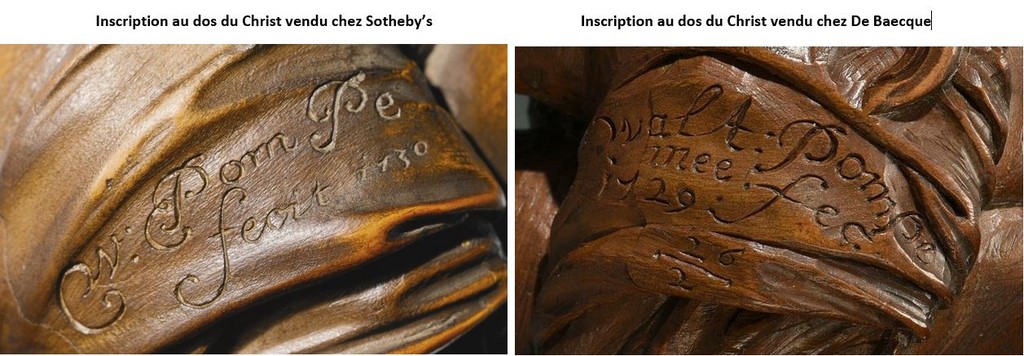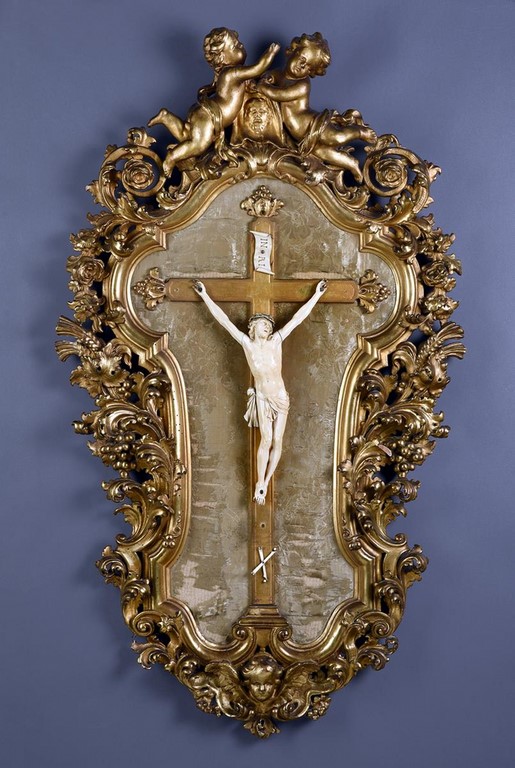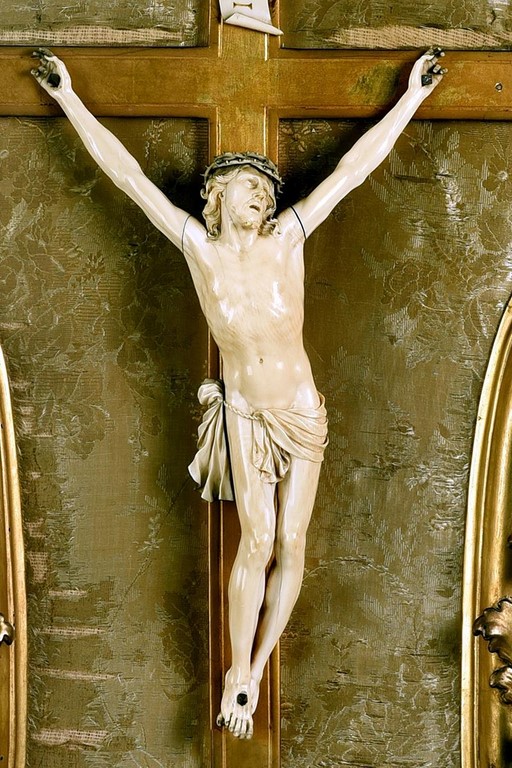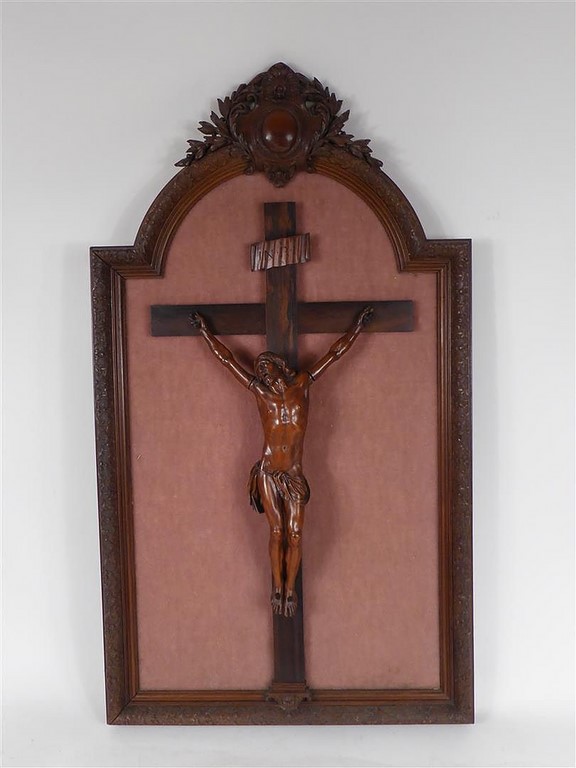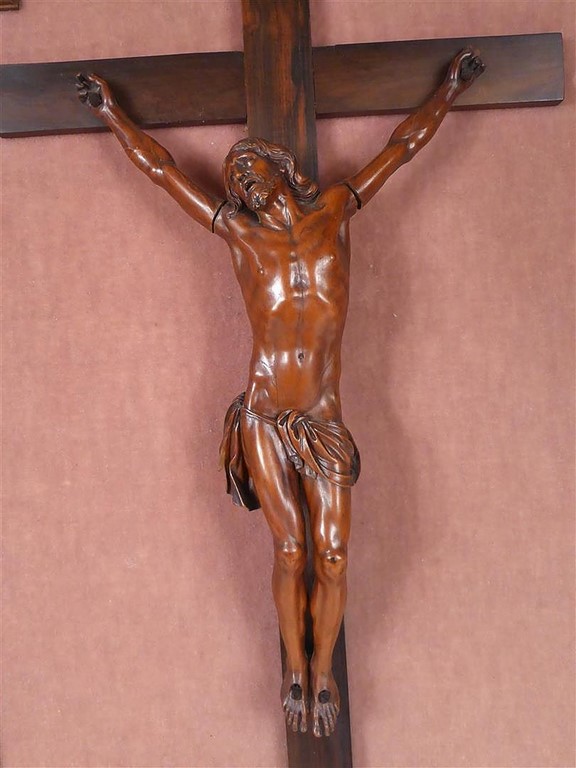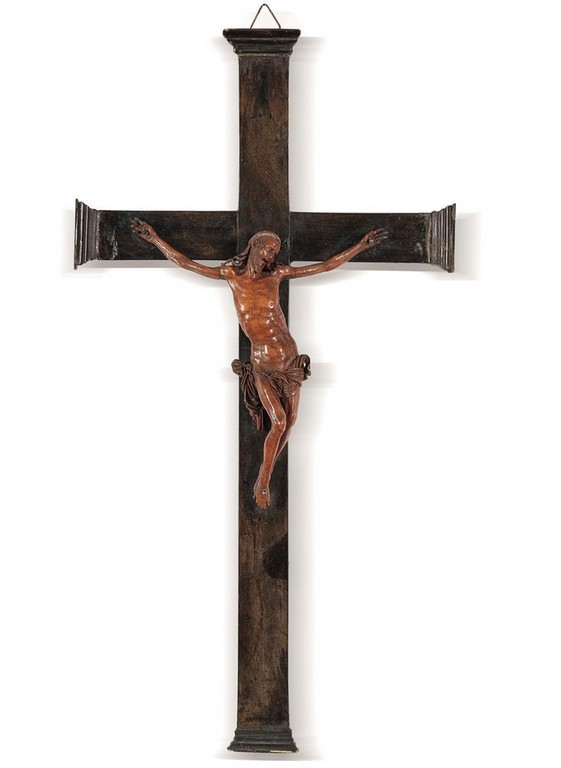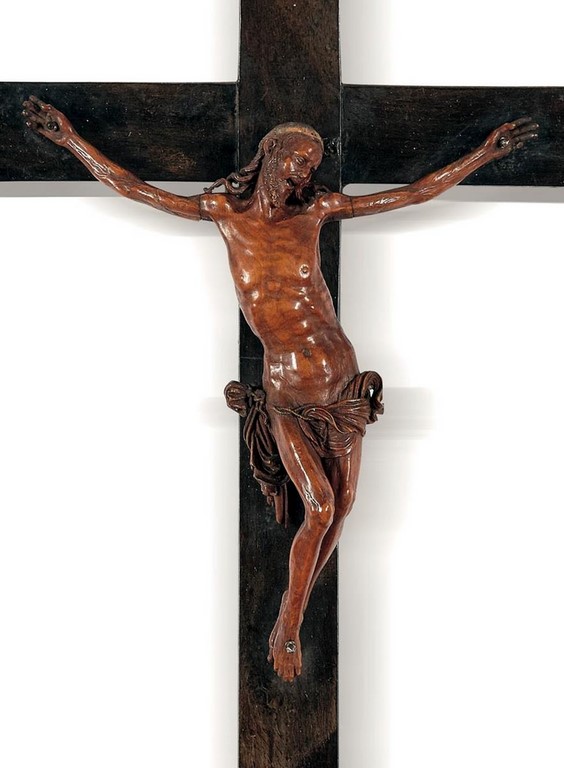Novembre & Décembre 2019 - Enchères
Le 16 novembre 2019 la SVV De Baecque & Associés a adjugé 1 700€ au marteau un Christ en buis attribué à Walter POMPE (1703-1777), une attribution justifiée par une inscription sur le perizonium ainsi libellée Walt Pompe fec. année 1729 26/2
Au regard de la notoriété de Walter POMPE considéré comme un des plus grands sculpteurs flamands du XVIIIe siècle je suis étonné par la modestie de l’estimation qui a été fournie et par voie de conséquence par la modestie du montant de l’adjudication.
Pour mémoire un Christ en buis similaire a été mis aux enchères le 5 décembre 2012 à Londres chez Sotheby’s portant le N° de lot 75. A cette date il était estimé dans la fourchette de prix 15 000£-20 000£. Avec un Taux de Change de 1.22€ pour 1 £ cela donne une estimation de 18 000€-24 000€ soit une estimation 20 fois supérieure à celle de la SVV De Baecque !
Sur l’envers du perizonium du Christ vendu par Sotheby's était inscrit W.Pompe Fecit 1730 dans le même style d’écriture que l'inscription visible sur le Christ vendu par De Baecque.
L’Acheteur qui a remporté le Christ adjugé à Lyon semble avoir réalisé une très belle affaire !
N° 78
Walter POMPE (1703-1777)
Beau Christ en buis à périzonium noué
Signé au dos "Walt Pompe Fec., année 1729", 26/2
XVIIIe siècle
H. totale: 33,5 cm BL
Petits manques
Estimation : 800 à 1 000€
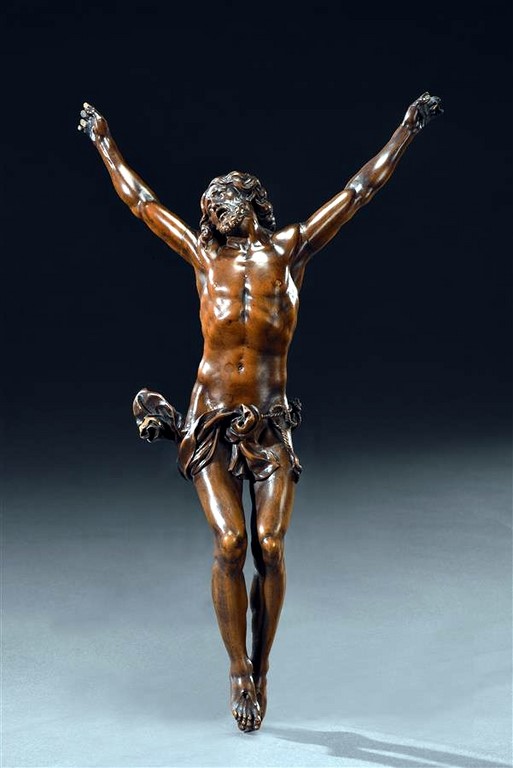
Au cours de la même vacation un spectaculaire Crucifix en ivoire d’une hauteur totale de 1.10 m a été adjugé 1 500 € au marteau. Auparavant et à 2 reprises : le 10 novembre 2018 puis le 9 mars 2019, la SVV De Baecque avait échoué de vendre cet ensemble dans la fourchette de prix 2 000€-3 000€.
La crainte dans un proche avenir, que le commerce de l'Ivoire soit totalement interdit tire vers le bas le prix des lots composés d'ivoire dont le commerce reste légal à savoir les productions antérieures au 2 mars 1947. (Arrêté du 4 mai 2017 portant modification de l'arrêté du 16 août 2016 relatif à l'interdiction du commerce de l'ivoire d'éléphants et de la corne de rhinocéros sur le territoire national)
N°126
Spectaculaire crucifix en ivoire,
le Christ vivant dans un cadre en bois doré mouvementé mouluré et sculpté à jours de volutes feuillagées et fleuries, sommé de deux chérubins tenant le voile de la Sainte Face Italie, XVIIIe siècle
H. du Christ : 30,5 cm - H. avec les bras : 36,5 cm BL H. totale 110 cm L. 64 cm
Reprises à la dorure, très petit manque et manque le crâne.
Ce lot en ivoire fera l'objet d'une déclaration d'achat par nos soins (Conformément à l'article 2 bis de l'arrêté du 16 août 2016 modifié)
Estimation : 1 200 - 1 500 €
Lempertz est une des Maisons de Vente parmi les plus anciennes d’Europe. Le 16 novembre 2019 elle a adjugé 8 000€ au marteau ce remarquable Christ en bois attribué au XVIIe siècle naissant dans la ville de Malines. Son origine géographique est garantie par la marque de la Cité de Malines estampillée sous le pied gauche.
Le 17 novembre 2018, la même Maison de Ventes avait échoué à vendre ce Christ dans la fourchette d’estimations 14 000€-16 000€ !
Lot N° 1332
Mecheln um 1600
Corpus Christi
Holz, vollrund geschnitzt, Arme erkennbar angesetzt. Ältere und wohl originale farbige Fassung, in Teilen retuschiert und im Bereich des Lendentuchs übergangen. Auf leichte Unteransicht gestalteter Corpus Christi im Viernageltypus und in gelängten Proportionen, die Arme sind weit auseinander gezogenen, das Haupt des Sterbenden ist zur Seite geneigt. Die Qualität der Schnitzarbeit zeigt sich zum einen in der Erfassung der ausdrucksstarken Physiognomie und der feinen Ausführung der welligen Haare, zum anderen ist neben der Modellierung des Körpers besonders die ausgewogene Gestaltung der naturalistischen Gegenbewegung von Ober- und Unterkörper hervorzuheben. Unter dem linken Fuß die Marke der Stadt Mecheln; zuletzt ist als Schnitzer Thomas Hazart (um 1530/1540 - 1610) vorgeschlagen worden.
Finger wieder angesetzt bzw. verloren. Nur geringfügige Bestoßungen. Mit Hilfe von Metallstangen auf Metallsockel montiert. Höhe 61 cm, Armspanne 44 cm.
Corpus Christi
Holz, vollrund geschnitzt, Arme erkennbar angesetzt. Ältere und wohl originale farbige Fassung, in Teilen retuschiert und im Bereich des Lendentuchs übergangen. Auf leichte Unteransicht gestalteter Corpus Christi im Viernageltypus und in gelängten Proportionen, die Arme sind weit auseinander gezogenen, das Haupt des Sterbenden ist zur Seite geneigt. Die Qualität der Schnitzarbeit zeigt sich zum einen in der Erfassung der ausdrucksstarken Physiognomie und der feinen Ausführung der welligen Haare, zum anderen ist neben der Modellierung des Körpers besonders die ausgewogene Gestaltung der naturalistischen Gegenbewegung von Ober- und Unterkörper hervorzuheben. Unter dem linken Fuß die Marke der Stadt Mecheln; zuletzt ist als Schnitzer Thomas Hazart (um 1530/1540 - 1610) vorgeschlagen worden.
Finger wieder angesetzt bzw. verloren. Nur geringfügige Bestoßungen. Mit Hilfe von Metallstangen auf Metallsockel montiert. Höhe 61 cm, Armspanne 44 cm.
An early 16th century Mechelen carved wooden Corpus Christi
Carved in the round, the arms visibly attached. With presumably original polychromy. Partial retouches and overpainted to the area around the perizonium. A figure of Christ crucified with four nails, designed for a slightly lowered viewpoint. He is depicted with elongated proportions with his arms outstretched. The quality of the carving is particularly evident in the facial expression and the fine curls of the hair. Alongside the skilful rendering of the anatomy, the figure is also characterised by the naturalistic ponderation of the upper and lower body. The figure is stamped with the city mark of Mechelen under the left foot.
Some fingers lost or reattached. Minimal wear. Mounted to a metal plinth via metal clamps. Height 61 cm, width of arms 44 cm.
Estimation : 10 000/12 000€
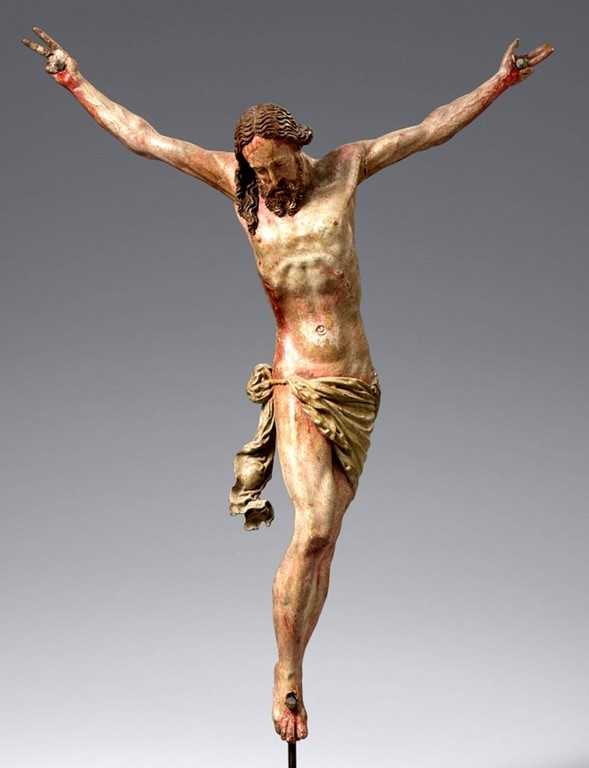
De nombreux Christs en Ivoire de grandes dimensions sortent de leurs réserves car certains Intervenants sur le Marché de l’Art anticipent une interdiction totale du commerce de l'ivoire. Ainsi, au cours de la même vacation du 16 novembre 2019 chez Lempertz, un Christ en Ivoire haut de 61 cm estimé dans la fourchette de prix 6 000 €-8 000 € a été offert à la vente ... et ravalé. Par contre ...
Le 18 novembre 2019 la SVV May Associés basée à Roubaix a réussi la vente d’un Christ en Ivoire haut de 70 cm donc plus grand que celui proposé à la vente par Lempertz et surtout modestement estimé dans la fourchette de prix 2 000€-3 000€.
Ce Christ d’un poids spectaculaire de 8.5 Kg a été adjugé 7 200€ au marteau.
Cependant je vous déconseille d’acquérir les Christs en Ivoire dont les modèles datent de la fin du XIXe siècle/début du XXe siècle. Les modèles en bronze aussi appelés chablons qui ont servi à les produire de façon mécanique n’ont probablement pas été détruits. Ils ont pu servir à reproduire des Christs à l’identique après la date fatidique du 2 mars 1947.
N° 205
Très important Christ en croix en ivoire sculpté.
Vers 1880.
Elephantidae spp
Hauteur : 70 cm
Largeur : 58 cm
Poids brut : 8.5 kg
(légères fentes)
FR1905900389-D
Estimation : 2 000 - 3 000 €
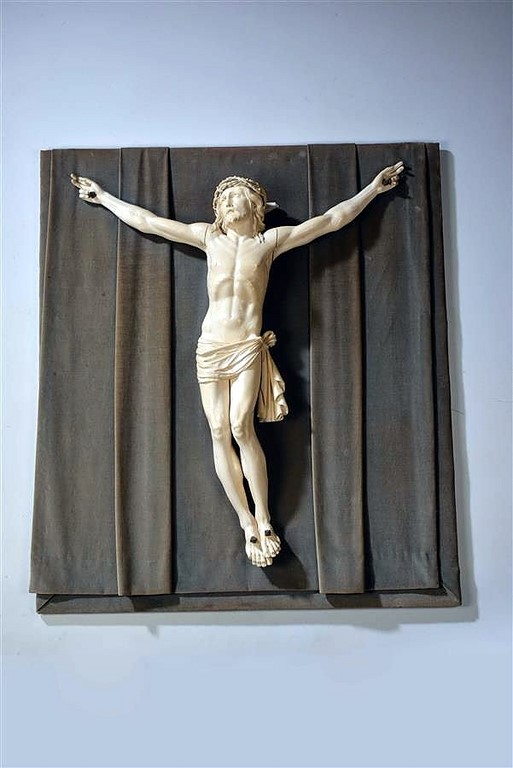
Les SVV en France n’ont pas vocation à orchestrer des enchères à la hollandaise en soumettant un bien à un prix plus élevé que sa valeur et en réduisant progressivement son prix jusqu’à ce qu’il trouve un acquéreur.
Pourtant, il n'est pas rare d’observer des cycles de vente qui s’apparentent à des enchères à la hollandaise.
2 exemples relevés au cours du mois de Novembre 2019 :
1er exemple : ce Christ nu adjugé 1 700€ au marteau par la SVV Aguttes le 19 novembre 2019
C’était la 4ième fois que je le voyais passer en vente :
-La 1ère fois chez Coutau-Bégarie le 29 mai 2015 sous le N°158 Il était estimé 4 000€-6 000€
-La 2nde fois chez Coutau-Bégarie le 27 mai 2016 sous le N°183 Il était estimé 2 500€-3 500€
-La 3ième fois chez Aguttes le 20 septembre 2016 sous le N°90 Il était estimé 2 000€-2 500€
-La 4ième fois chez Aguttes le 19 novembre 2019 sous le N°21 Il était estimé 1 200€-1 800€
Lot n°21
CHRIST
en bronze à patine brune
XVIIe siècle
H: 26 cm ; L : 21 cm
Estimation : 1 200 -1 800 €
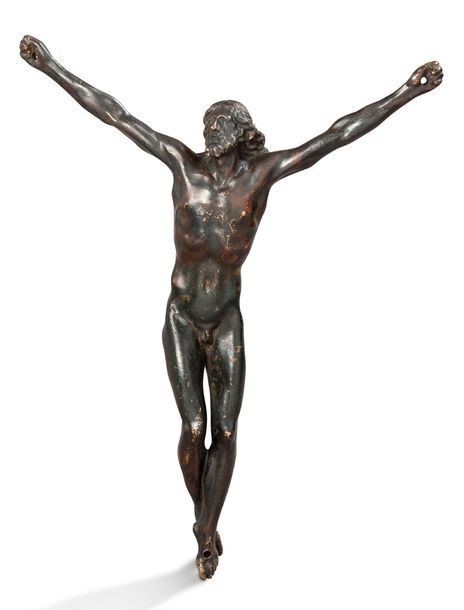
2nd exemple de cycle d’enchères qui s’apparente à des enchères hollandaises avec ce Cadre-Crucifix attribué avec audace au XVIIIe siècle
A nouveau un lot que j’ai vu passer à 4 reprises en vente :
-La 1ère fois chez Thomas Maison de Ventes à Maubeuge le 25 mars 2017 sous le N°144 Il était estimé 800€-1 200€
-La 2nde fois chez Thomas Maison de Ventes à Maubeuge le 2 juin 2018 sous le N°221 Il était estimé 500€-700€
-La 3ième fois chez Thomas Maison de Ventes à Maubeuge le 27 avril 2019 sous le N°303 Il était estimé 300€-500€
-La 4ième fois chez Thomas Maison de Ventes à Douai le 23 novembre 2019 sous le N°62 Il était estimé 250€-450€ où il a été enfin adjugé 200€ au marteau soit à un prix 4 fois inférieur à sa 1ère estimation
Lot n°62
Crucifix en bois de Sainte-Lucie, le christ en buis sculpté;
le cadre cintré à décrochement à décor de feuillages stylisés sur fond amati surmonté d'un cartouche feuillagé.
XVIIIe siècle (la croix probablement refaite ainsi que le fond de velours)
(H : 85 cm, L : 50 cm)
Ref. : V493 - 2
Estimation : 250 - 450 €
Ref. : V493 - 2
Estimation : 250 - 450 €
Je suis souvent sollicité pour donner à titre indicatif une estimation aux Crucifix en Ivoire hérités de Parents ou de Grands Parents donc des Crucifix qui datent au mieux du début du XXe siècle. A chaque fois ma réponse provoque la même déception car mon estimation pour un Christ en Ivoire de 15 cm tête-pieds ne dépasse guère une centaine d’Euros, le double pour un Christ de 20 à 25 cm tête-pieds.
Un exemple type de Crucifix en Ivoire offert à l’occasion d’une Communion est ce Crucifix signé D.Manceau adjugé 250€ au marteau le 24 novembre 2019 par Me Ossenat à Fontainebleau.
Pour mémoire je rappelle que la marque D.Manceau ne signifie pas que l’objet a été sculpté par Désiré Manceau (1838-1917). Après son décès une Société a été créée qui portait le nom D.Manceau et qui a été active jusqu’en 1956. Rien n’exclut donc que des Christs en Ivoire marqués D.Manceau aient été produits après le 2 mars 1947. Ils seraient donc interdits à la vente.
Lot N° 60
Désiré MANCEAU (1838-1917)
Christ en ivoire
Signé
Encadrement en bois doré à fronton semi-circulaire
Haut.Christ : 24 cm
50 x 35 cm
Estimation 200- 300 €
Christ en ivoire
Signé
Encadrement en bois doré à fronton semi-circulaire
Haut.Christ : 24 cm
50 x 35 cm
Estimation 200- 300 €
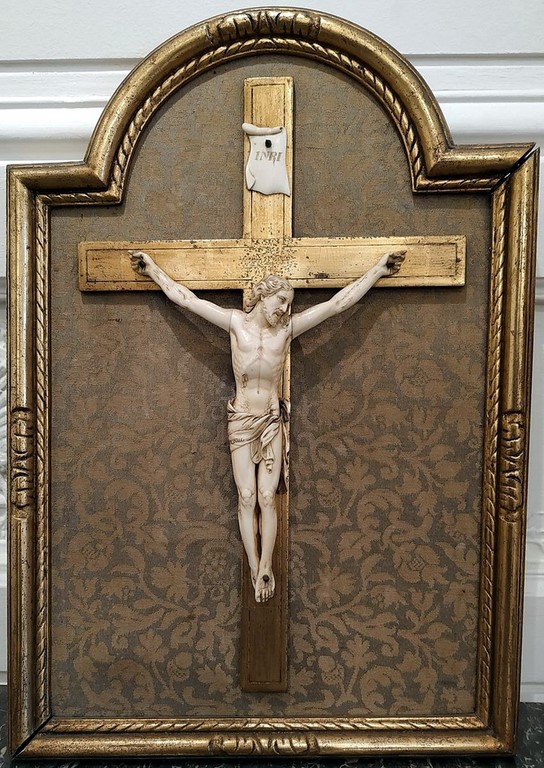
Les résultats de vente chez Christie's ont parfois quelque chose de surréalistes ...
Exemple ce Christ en or attribué à un sculpteur italien du XVIe siècle GASPARO MOLA (ACTIVE FLORENCE 1571-1640 ROME). Estimé entre 200 000£ et 300 000£ il a été adjugé 671 250£ (frais inclus) le 3 décembre 2019 par Christie's à Londres.
Une littérature prolifique accompagne le descriptif de ce Christ en or. En suivant ce lien CRISTO MORTO vous le découvrirez directement sur le site de Christie's.
Lot N° 33
GASPARO MOLA (ACTIVE FLORENCE 1571-1640 ROME), FLORENCE, CIRCA 1597-1606
CRISTO MORTO
Gold figure; on original ebony cross, inlaid with gold thread, surmounted by a partially enamelled gold cartouche inscribed 'INRI', the ebony base decorated with a gold plaquette depicting the Lamentation
8 in. (20.2 cm.) high, gold corpus; 25½ in. (64.8 cm.) high, overall
Provenance
Private collector, England, by whom acquired in France.
Acquired from the above by Michael Hall, circa 1965.
CRISTO MORTO
Gold figure; on original ebony cross, inlaid with gold thread, surmounted by a partially enamelled gold cartouche inscribed 'INRI', the ebony base decorated with a gold plaquette depicting the Lamentation
8 in. (20.2 cm.) high, gold corpus; 25½ in. (64.8 cm.) high, overall
Provenance
Private collector, England, by whom acquired in France.
Acquired from the above by Michael Hall, circa 1965.
Literature
C. Avery, Giambologna: Sculpture by the Master and His Followers, New York, 1998, pp. 68-72, no. 22.
A. di Lorenzo (ed.), ‘Il Crocifisso d’oro del Museo Poldi Pezzoli, Giambologna e Gasparo Mola’, Quaderni di Studi e Restauri del Museo Poldi Pezzoli, IX, Milan, 2011.
C. Avery, Giambologna: Sculpture by the Master and His Followers, New York, 1998, pp. 68-72, no. 22.
A. di Lorenzo (ed.), ‘Il Crocifisso d’oro del Museo Poldi Pezzoli, Giambologna e Gasparo Mola’, Quaderni di Studi e Restauri del Museo Poldi Pezzoli, IX, Milan, 2011.
Exhibited
New York, The Metropolitan Museum of Art, Gold, 1972-1973.
New York, American Bible Society, Icons or Portraits? Images of Jesus and Mary from the Collection of Michael Hall, July 26 - Nov. 15 2002, E. Heller ed., no. 79.
Lot Essay
The present crucifix is an incredibly fine and rare survival of a statuette in gold from the Renaissance. Gold has long had a mythical quality, and during the Renaissance it was considered the finest and most luxurious material, only available to the richest royal and ecclesiastical authorities. The ability to make statues in gold was one of the hardest challenges for an artist, and accordingly only specialised goldsmiths were allowed to work with such a precious commodity. The present crucifix has recently been convincingly added to the oeuvre of the Medici goldsmith Gasparo Mola, who gained fame across Europe for his unsurpassed ability to work with gold.
The Crucifix in the Renaissance
During the Italian Renaissance the carving of a Crucifix became an occasion for a sculptor to demonstrate his mastery in his field. The Crucifix was no longer just an object of devotion but at the same time a manifesto of a sculptor’s understanding of anatomy and their ability to create a work of art of extreme sanctity. Vasari recorded how Brunelleschi criticised the exaggerated naturalism of a wooden crucifix by Donatello, calling it a 'peasant on the cross' instead of the body of Jesus Christ. Challenged by Donatello to do better, Brunelleschi carved such a sublime work that at the sight of it Donatello dropped to the ground and smashed the eggs in his lap that he had brought for dinner (G. Vasari, Lives of the Painters, Sculptors and Architects, vol. 1, translated by Gaston du C. de Vere, republished Everyman's Library, 1996, pp. 328-9). By the end of the sixteenth century, the desire amongst leading artists to tackle this subject and the precepts of the counter-Reformation created a vogue for small Crucifixes amongst the ecclesiastical and aristocratic classes.
Three Gold Crucifixes
The present gold and ebony crucifix is one of three known examples; the other versions are in the Museo della Città, Rimini (fig. 1) and in the Museo Poldi Pezzoli, Milan. The Rimini example was donated to the city of Rimini on 27th March 1612 by Cardinal Michelangelo Tonti (1566-1622). Tonti was a favourite of Camillo Borghese, who elevated Tonti to Cardinal after he became Pope Paul V in 1605. Tonti was the Pope’s most influential advisor, and through this was able to provide his hometown of Rimini with substantial funding. Tonti’s influence eventually led to his downfall, and he was forced out of Rome in 1612 to settle in Cesena. It was during this journey he visited Rimini and donated the golden crucifix to his citizens. The Poldi Pezzoli example also has an early provenance; it was part of the Riccardi collection, mentioned in the household goods of the Marquesses Gabbriello and Francesco Riccardi in 1671, recorded in several subsequent inventories and almost certainly the same one that was eventually donated to the museum in 1987, due in part to the description of the base in those inventories, which do not correspond to the Rimini or Michael Hall examples (di Lorenzo, loc. cit.).
The three crucifixes were analysed closely in a study undertaken by Andrea Di Lorenzo, Davide Gasparotto and Lorenzo Morigi in 2011 (ibid.). This study identified the Michael Hall example as being entirely original and intact. As the most complete example it was used as a point of comparison for the two other crucifixes. The present lot preserves the crown of thorns in gold on the head of Christ and is still fixed with three gold nails on its original ebony cross, in which a thin gold thread is inlaid along the entire perimeter. The cross is grafted onto a base made of the same technique, of ebony inlaid with a gold thread. On the cross is a cartouche with the legend ‘INRI’ in gold and polychrome enamels, analogous to the Rimini cross, while at the centre of the base is a gold plaque depicting the Lamentation, which is almost identical to the Rimini plaque, except for some additional details. All three crucifixes have the same trapezoidal hole at the reverse, which allowed the sculptor to remove the stucco core from the inside. In contrast to the Michael Hall example, the Rimini cross is a later replacement, as is the base of the Poldi Pezzoli version.
Gasparo Mola: Goldsmith to the Medici
Gasparo Mola first worked in Milan as a goldsmith; his earliest extant work is an engraved silver crucifix, signed and dated 1592 (Church of Tavernerio, near Como). He was then lured to Florence to work for the Grand Duke of Tuscany Ferdinando I de’ Medici. For Ferdinando he is known to have made some richly decorated weapons in gold and enamel, and two bronze panels for the door of the Cathedral of Pisa. In 1597 Mola was given the role of die-cutter at the Florentine Mint.
Mola is documented as having produced crucifixes from gold for the Grand Duke of Tuscany. In 1600 he was asked to produce crucifixes and other items in addition to his job at the Mint. The lack of a salary increase resulted in Mola leaving Florence for Turin, but he was back in Florence by 1609, and created two crucifixes in gold for Cosimo de Medici in 1611-12. Such gold crucifixes realised by Mola for the Medici are listed in several inventories throughout the 17th century (di Lorenzo, op. cit., pp. 29-30). However, these crucifixes measured 3/5 of a braccio fiorentino, approximately 35-40 cm., and therefore do not correspond to the crucifixes mentioned above.
Mola gained great celebrity in his day for his ability to makesuch sculptures in gold foil. The Hall, Rimini and Poldi Pezzoli crucifixes are not cast but have been carefully beaten into form using the repoussé method. The hands and the feet were cast and welded onto the body (ibid, pp. 59-63). This was a difficult and much admired technique, which very few goldsmiths mastered.
Gasparo Mola and Guglielmo della Porta
The source for the model of the present corpus figure has traditionally been attributed to Giambologna, due to his erroneous association with a silver crucifix in the Palazzo Apostolico in Loreto. More recently, Rosario Coppel has attributed the model to the Roman sculptor Guglielmo della Porta (R. Coppel et. al., Guglielmo della Porta: A Counter-Reformation Sculptor, Coll & Cortes, Madrid, 2012, pp. 62-73). Neither della Porta nor Giambologna were goldsmiths themselves, and it is very likely that Mola used and modified a model that della Porta had created by at least 1570.
Further evidence in favour of the attribution to Mola is the inclusion in the bases of the Hall and Rimini crucifixes of a plaque depicting the Lamentation of Christ that derives from a painting by Gaudenzio Ferrari (c.1471-1546), in the Szépmuvészeti Museum, Budapest (inv. no. 3540). It is unusual that a much earlier painting, which dates from between 1527 and 1529, was used as a source for this plaque. However, Gasparo Mola was both a collector and dealer in works of art, and in 1606 he sold this painting to the Duke of Mantua. Before 1606 he presumably owned the painting himself, and thus was able to use it as a model for his plaque. 1606 is therefore a likely terminus ante quem for the creation of the present crucifix.
The presence of fleur-de-lis decoration on the perizonium of the present crucifix, a motif associated with the city of Florence, together with Mola’s occupation working for both Ferdinando II and Cosimo de Medici, suggests that the present crucifix may have been a Medici commission, possibly intended as a gift to royal and noble dignitaries abroad.
Gold testing carried out on 23/10/19 showed a gold purity in excess of 22 karats.
Estimation GBP 200,000 - GBP 300,000
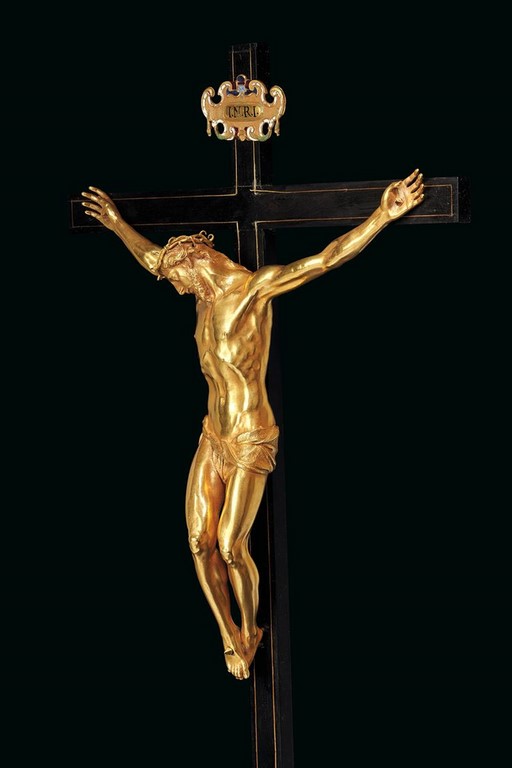
Le 12 Décembre 2019 la Maison de Ventes Cambi basée dans la ville de Gênes en Italie a adjugé 1 300€ au marteau ce Christ en buis dont l'iconographie est originale. Il est attribué à un sculpteur allemand anonyme du XVIIIe siècle.
Lot N° 34
A boxwood Corpus Christi, Germany, 1700s
14x13cm, ebonised wood cross (probably not coeval) 37.5x20cm
14x13cm, ebonised wood cross (probably not coeval) 37.5x20cm
Estimation 800-1 000€
Le 18 décembre 2019 la SVV Pierre Bergé & Associés a adjugé 102 000€ au marteau un rare Christ en bronze produit pendant la première moitié du XIIe siècle selon son descriptif et toujours solidaire de sa plaque d'origine. Plus de photos sur le site pba-auctions.com
Lot N° 14
Plaque centrale de croix en bronze et cuivre ciselé, gravé et doré.
Christ: long cou tendu avec tête avancée, inclinée sur la gauche, chevelure partagée par une raie médiane, longues mèches reposant sur les épaules, moustaches en virgule et barbe courte; bras à l'horizontale avec avant-bras relevés et mains fléchies aux pouces en adduction; anatomie encore influencée par le type byzantin avec pectoraux en pèlerine, nombreuses côtes sous-mammaires et abdomen légèrement gonflé; long perizonium s'arrêtant au-dessus des genoux avec repli médian en V et noeud sur la hanche droite; jambes fléchies déportées à gauche et pieds juxtaposés.
Croix: branches se terminant en chapiteau à volutes; intersection en cercle crucifère portant l'alpha et l'omega et, derrière les épaules du Christ, IN RI (monogramme du Christ).
Inscriptions aux extrémités et sur le cercle: à gauche, [CHRISTVS] REX OBIT IN [CRVCE] (Le Christ roi meurt sur la croix);
Christ: long cou tendu avec tête avancée, inclinée sur la gauche, chevelure partagée par une raie médiane, longues mèches reposant sur les épaules, moustaches en virgule et barbe courte; bras à l'horizontale avec avant-bras relevés et mains fléchies aux pouces en adduction; anatomie encore influencée par le type byzantin avec pectoraux en pèlerine, nombreuses côtes sous-mammaires et abdomen légèrement gonflé; long perizonium s'arrêtant au-dessus des genoux avec repli médian en V et noeud sur la hanche droite; jambes fléchies déportées à gauche et pieds juxtaposés.
Croix: branches se terminant en chapiteau à volutes; intersection en cercle crucifère portant l'alpha et l'omega et, derrière les épaules du Christ, IN RI (monogramme du Christ).
Inscriptions aux extrémités et sur le cercle: à gauche, [CHRISTVS] REX OBIT IN [CRVCE] (Le Christ roi meurt sur la croix);
en haut, L[AVS] IN NO[MINE] PROT[ECTORIS NOSTRI] (Louange au nom de notre protecteur);
à droite, Q[VI] P[ERPETVO] LAV[DA] TVS S[IT] (Qu'il soit loué à jamais);
en bas, [RES] VRGIT B[E]N[E]I (?) M[ERI]TO (Il ressuscite à bon droit);
sur le cercle, + PRO CRVCIS INDIQVE (pour INDICATIONE) X (CHRISTVS SATVRNI [REGNO NOS ERADICAVIT] (En échange du prix de sa croix, Christ nous a arrachés au règne de Saturne)
Ouest de la France, première moitié du XIIe siècle Hauteur: 28,8 cm - Largeur: 24 cm
Christ, Hauteur: 16,3 cm - Largeur: 16,8 cm
Fixée sur un crucifix en bois noirci XVII/XVIIIe (dorure usée)
Ouest de la France, première moitié du XIIe siècle Hauteur: 28,8 cm - Largeur: 24 cm
Christ, Hauteur: 16,3 cm - Largeur: 16,8 cm
Fixée sur un crucifix en bois noirci XVII/XVIIIe (dorure usée)
Provenance
ancienne collection privée, Nantes, dans la famille depuis le XIXe siècle Le Christ de cette plaque centrale de croix, d'une facture particulièrement raffinée, est un modèle assez rare. Un seul autre exemplaire semble avoir été répertorié par le Docteur Paul Thoby, ancien conservateur honoraire du musée départemental Thomas Dobrée de Nantes, auteur d'un remarquable ouvrage sur le Crucifix. Illustré sous le n°144, pl. LXIV, il est indiqué comme étant conservé dans une famille de Belligné (Loire-Atlantique) et provenant probablement de l'abbaye de Pontron située non loin de ce village. Le Docteur Thoby établit une comparaison avec un autre Christ conservé au musée Saint-Jean d'Angers et trouvé à Soudan dans le même département; son perizonium davantage élaboré indique pour lui une réalisation plus tardive, de la seconde moitié du XIIe siècle. Le livre de Peter Bloch sur les crucifix romans en bronze publie également le Christ de Belligné en reprenant les mêmes informations (fig.). Ces éléments, mis en relation avec la provenance nantaise de cette plaque centrale de croix, permettent ainsi d'avancer une origine de l'Ouest de la France pour cette production. Le Christ en bronze est ici sur sa plaque d'origine, très rarement conservée, ce qui constitue un ensemble particulièrement remarquable.
Ouvrages consultés
Dr P. Thoby, Le Crucifix des Origines au Concile de Trente, La Roche-sur-Yon, 1959, p 105, n° 144, pl. LXIV;
P. Bloch, Bronze-Romanische Kruzifixe, Bronzegerate des Millelalters, t.5,. Berlin, 1992, p 214, V B 7, pl. p 92.
Estimation 30 000-40 000€
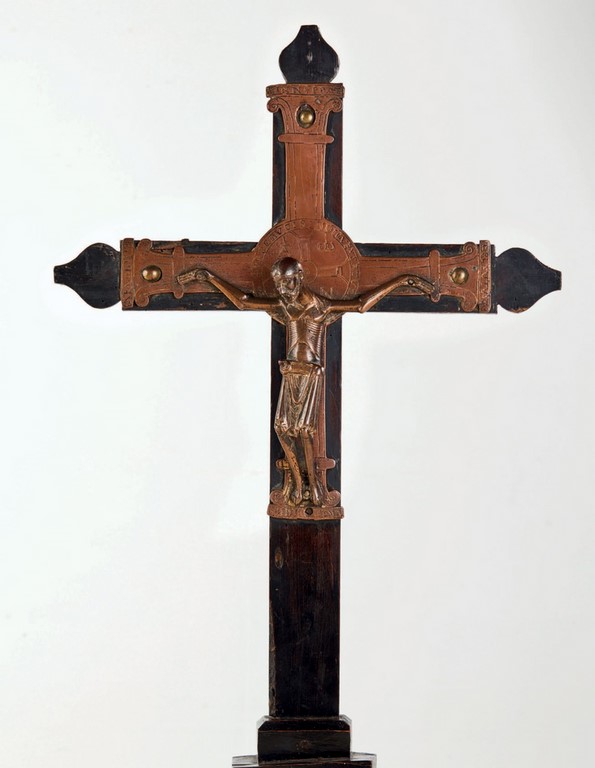
Publié le 26 janvier 2020
